Sarah Sundin's Blog, page 497
November 26, 2011
Today in World War II History
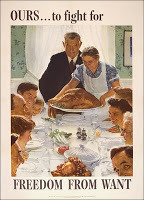 70 Years Ago—Nov. 26, 1941: Japanese fleet departs Kuriles for Pearl Harbor. Roosevelt officially establishes Thanksgiving as fourth Thursday in November, reversing unpopular 1939 decision that moved it one week earlier to extend shopping season.
70 Years Ago—Nov. 26, 1941: Japanese fleet departs Kuriles for Pearl Harbor. Roosevelt officially establishes Thanksgiving as fourth Thursday in November, reversing unpopular 1939 decision that moved it one week earlier to extend shopping season.
Published on November 26, 2011 03:00
November 25, 2011
Today in World War II History
70 Years Ago—Nov. 25, 1941: Australian troops from Tobruk link with New Zealanders at Ed Duda, Libya. British battleship HMS Barham sunk by U-331 off Bardia, Libya; 862 killed. US rejects Japanese proposal and insists Japan withdraws from Indochina and China.
Published on November 25, 2011 03:00
November 24, 2011
Today in World War II History
70 Years Ago—Nov. 24, 1941: Two German POWs in Britain escape by forging papers & stealing RAF plane, but are recaptured when they run out of fuel. Rommel splits Allied forces in Libya, but fails to advance.
Published on November 24, 2011 03:00
November 23, 2011
The Advent Wreath - Messiah Is Coming!
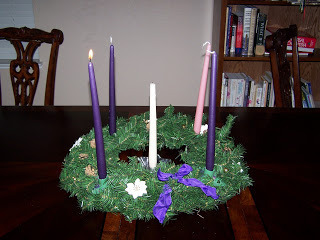 One of my family's favorite Christmas traditions is the Advent wreath. On each of the four Sundays in Advent (the four weeks before Christmas), our family gathers around the wreath with cookies and eggnog and hot chocolate. We light the candles, read Scripture passages, and sing carols. Not only is this cozy family time, but it focuses us with joyful anticipation on the birth of Jesus.
One of my family's favorite Christmas traditions is the Advent wreath. On each of the four Sundays in Advent (the four weeks before Christmas), our family gathers around the wreath with cookies and eggnog and hot chocolate. We light the candles, read Scripture passages, and sing carols. Not only is this cozy family time, but it focuses us with joyful anticipation on the birth of Jesus.The Advent wreath became popular in Germany and Scandinavia, and worked its way to Britain and America. Traditionally it's a flat evergreen wreath with four candles - three purple and one pink, or four red candles - with a white candle in the middle. Even the least crafty person in the world (that would be me) can put one together.
Each Sunday one more candle is lit, going in a clockwise pattern - purple (Prophet's Candle), purple (Bethlehem Candle), pink (Shepherd's Candle), purple (Angels' Candle). On Christmas Day, all four candles in the wreath are lit, plus the white Christ Candle in the center. This symbolizes the coming light of Jesus Christ, the Light of the World. This Sunday (November 27), is the first Sunday in Advent. If you'd like to join the Sundin family in this tradition, here are some family friendly, kid-tested ideas.
Each element can be adapted to the ages of any children present - and personalized for your family.
Advent Week One - the Prophet's Candle.
Candles: Light one purple candle, the Prophet's Candle. Traditionally the youngest child lights the candles, but this can be shared.
Story: (adapt to the ages of your children) The Old Testament prophets told of a coming Messiah, or Savior - hundreds of years before Jesus was born. He would come into the dark world and bring light. Explain how prophets spoke God's word to people. Ponder what the world must have been like without the hope of Christ.
Scriptures:
Isaiah 11:1-10 (explains how the Messiah would come from David's line)
Isaiah 7:14 (Messiah to be born of a virgin)
Luke 1: 26-38 (the angel Gabriel appears to Mary)
Matthew 1: 18-24 (the angel appears to Joseph)
Songs:
"O Come, O Come, Emmanuel"
"Come, Thou Long Expected Jesus"
Does your family or church use an Advent wreath, and does it help you get in the true Christmas spirit?
Published on November 23, 2011 05:00
Today in World War II History
70 Years Ago—Nov. 23, 1941: US occupies Surinam (Dutch Guiana) with cooperation of Dutch government-in-exile to secure bauxite mines.
Published on November 23, 2011 03:00
November 22, 2011
Today in World War II History
70 Years Ago—Nov. 22, 1941: German cruiser Atlantis sunk off west Africa by British cruiser HMS Devonshire after having sunk 22 Allied merchant ships. First Soviet truck convoy crosses frozen Lake Ladoga to supply besieged Leningrad. Luftwaffe ace Werner Mölders killed in landing accident while passenger on He 111.
Published on November 22, 2011 03:00
November 21, 2011
Make It Do - Scrap Drives in World War II
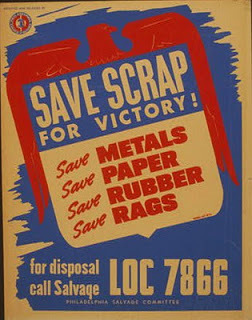 Perhaps nothing represents the community-minded patriotism of the US Home Front in World War II better than the scrap drive.
Perhaps nothing represents the community-minded patriotism of the US Home Front in World War II better than the scrap drive.Enemy conquests cut off supplies of crucial raw materials such as tin and rubber, and the need for products made from these materials skyrocketed due to the war. Since useful materials often ended up in the trash can or languished unused in homes and on farms, the War Production Board organized and encouraged scrap drives throughout the war.
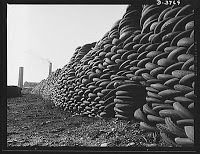 Rubber Drive
Rubber DriveFrom June 15-30, 1942, the United States held a nationwide rubber drive. People brought in old or excess tires, raincoats, hot water bottles, boots, and floor mats. In exchange they received a penny a pound. Although 450,000 tons of scrap rubber was collected, used rubber was found to be of poor quality.
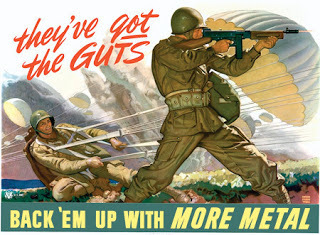 Scrap Metal Drives
Scrap Metal DrivesIn 1942 citizens scoured their homes, farms, and businesses for metal. Housewives donated pots and pans, farmers turned in farm equipment, and children even sacrificed their metal toys. Many people even removed bumpers and fenders from their cars for the war effort. Communities melted down Civil War cannons and tore down wrought iron fences, sacrificing their history for their future.These drives were often great community events, with performers, speeches, and opportunities to throw your scrap metal at a bust of Hitler. Competitions were held to see which town, county, and state produced the most scrap, and the winners boasted of their feats. These drives had mixed results. Used aluminum was found to be useless for aircraft, but used tin, steel, and copper were easily melted down and reused.
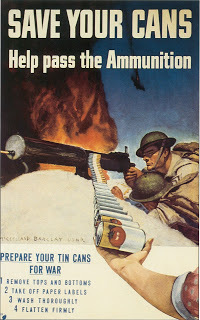 Tin Can DrivesThe use of tin packaging was greatly reduced during the war, partly due to the use of alternative packaging materials and partly due to rationing of canned goods. However, consumer use of tin continued throughout the war, and this valuable and irreplaceable resource needed to be recovered.
Tin Can DrivesThe use of tin packaging was greatly reduced during the war, partly due to the use of alternative packaging materials and partly due to rationing of canned goods. However, consumer use of tin continued throughout the war, and this valuable and irreplaceable resource needed to be recovered.Most communities collected tin cans once a month. In some towns, people places boxes of cleaned and crushed tin cans by the curb for collection, and other towns had central collection sites. Youth groups, especially the Boy Scouts, were highly involved in these drives.Paper Drives
The need for paper increased during the war. The military's love for paperwork could be blamed, but the military also used lots of paper packaging for supplies. On the civilian side, paper packaging had replaced tin for many products.A paper drive in mid-1942 brought in so much paper that the paper mills were inundated and actually called for a stop. However, by 1944 an acute paper shortage existed.
The lumber industry was hard-hit by the manpower shortage caused by the draft. Lumberjacks went on strike, demanding a higher meat ration, which they did not receive. Many of these men left for higher-paying jobs in the defense industry.Publishers found their paper allotment cut by 15 percent. Newspapers, magazines, and books were printed on fewer pages with thinner paper and narrow margins. Paperback books had been introduced in 1939 and also allowed for less paper. However, more scrap paper was needed.
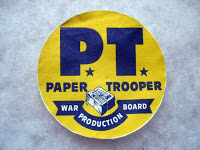 The children of America stepped up. The Boy Scouts and local schools organized regular paper drives, often coordinated with the tin can drives. The War Production Board started the Paper Troopers program, designed to sound like "paratroopers," to involve schoolchildren in the effort. Participants received arm patches and certificates for collecting certain amounts. Results
The children of America stepped up. The Boy Scouts and local schools organized regular paper drives, often coordinated with the tin can drives. The War Production Board started the Paper Troopers program, designed to sound like "paratroopers," to involve schoolchildren in the effort. Participants received arm patches and certificates for collecting certain amounts. ResultsThese scrap drives were a vital part of the American war effort. While not all scrap materials proved useful, many did and provided a small but significant source of material. Most importantly, these drives galvanized the Home Front and made each individual, even children, feel like a crucial part of the war effort.
Published on November 21, 2011 05:00
Today in World War II History
70 Years Ago—Nov. 21, 1941: Australian garrison at Tobruk attempts breakout to meet up with British thrust across Libya.
Published on November 21, 2011 03:00
November 20, 2011
Today in World War II History
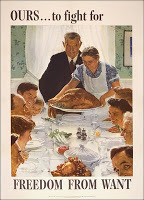 70 Years Ago—Nov. 20, 1941: Japanese negotiators in Washington present final proposal—they will withdraw from Indochina in exchange for a free hand in China and relaxed trade restrictions with US. United States celebrates Thanksgiving.
70 Years Ago—Nov. 20, 1941: Japanese negotiators in Washington present final proposal—they will withdraw from Indochina in exchange for a free hand in China and relaxed trade restrictions with US. United States celebrates Thanksgiving.
Published on November 20, 2011 03:00
November 19, 2011
Today in World War II History
70 Years Ago—Nov. 19, 1941: Cruiser HMAS Sydney sunk off western Australia by German cruiser Kormoran, all 645 killed. Kormoran also sinks, 78 killed.
Published on November 19, 2011 03:00



